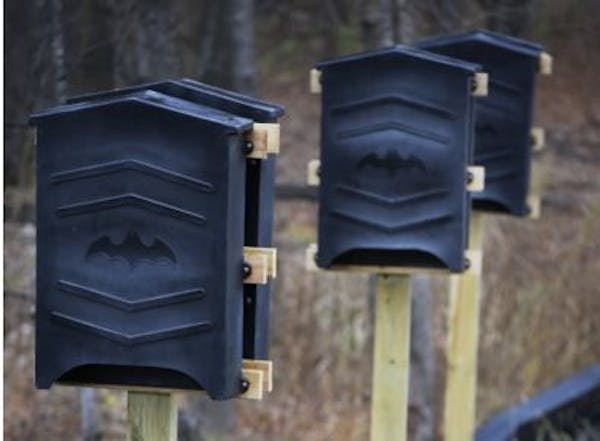White-nose syndrome has announced its dreaded arrival in Minnesota with the discovery that hundreds of bats died in the cold outside Lake Vermilion-Soudan Underground Mine State Park this winter.
The discovery, made in January and announced by state officials Wednesday, was expected, since evidence of the lethal fungus was found in 2013 at two winter hibernation sites, including the Soudan mine.
But it marks the beginning of an epidemic that is likely to decimate four of Minnesota's seven bat species, all of which play a critical role in controlling insects like mosquitoes, and which provide an estimated $3.7 billion in pest management and pollination to agriculture nationally.
It also adds new urgency to Minnesota research designed to help bats survive a disease that has killed 99 percent of their colonies elsewhere. Scientists say they have a narrow window of time to figure out what can be done to bring back an animal after its numbers plummet to endangered levels.
"We knew that this was inevitable that bats would start dying," said Morgan Swingen, a scientist at the University of Minnesota Duluth who is coordinating projects that track summer bat reproduction. "Now we will have some data that is pre-white-nose syndrome."
The disease, named for the distinctive white fuzz that appears on the face and wings of infected bats, is caused by an invasive fungus species from Europe. It doesn't harm bats there, for reasons that are not understood, but it has spread relentlessly westward since it was discovered in New York in 2007. It's now in 27 states and five Canadian provinces.
Three years ago, scientists from the Minnesota Department of Natural Resources found the fungus at the Soudan mine, the largest known bat colony in Minnesota, and a cave at Forestville/Mystery Cave State Park. They predicted the full-blown disease could strike Minnesota's bats within a few years.
Then in January, park managers at the Soudan mine noticed hundreds of bats flying out of the mine entrance into the bitter cold at a time when they should be hibernating in its warm depths, a typical behavior for infected colonies.
"They were dying of exposure," said Jim Essig, DNR park manager. "They would get caught in snow or ice or would just die."
Subsequent testing proved that they carried the fungus, state officials said.
Survey data this month
It's hard to predict how quickly the disease will spread here, scientists said. But based on experience in other states and Canada, Minnesota is likely to "slide into essentially a rapid spread," said Jeremy Coleman, white-nose syndrome coordinator for the U.S. Fish and Wildlife Service.
Wildlife officials will know more later this month, when they complete their annual survey of bat hibernation sites, but it would not surprise them to find the disease in other caves, said Gerda Nordquist, the DNR's bat expert. It's already hit populations in western Wisconsin that are known to move back and forth across the river to Minnesota's karst region, where caves are plentiful, she said.
The disease affects the four Minnesota species that winter in caves: the little brown bat and northern long-eared bat, found at the Soudan mine, and the tri-colored bat and big brown bat.
Since white-nose was discovered in New York, scientists across the country have been racing to find a cure, but combating a fungal disease is exceedingly difficult — as anyone with a stubborn toenail fungus knows, said Coleman. But some compounds are showing promise, he said.
In Minnesota, scientists are trying to better understand where bats go in the summer to reproduce, in the hope they can find a way to protect those sites to give bat populations a boost.
Swingen works with one of three research teams that capture bats in summer, as they swoop over forest roads and streams, and attach transmitters to the backs of females. The goal is to track them over several weeks to figure out what trees they choose to roost in and raise their young. Eventually, that would lead to a plan for managing forests to protect critical habitat.
"A species is only as good as its reproduction," said Rich Baker, the DNR's endangered species manager. With white-nose syndrome poised to sweep through the state's bats, he said, "it will be that much more important to provide for the reproduction success of the remaining individuals."
Josephine Marcotty • 612-673-7394

Souhan: Wolves fans made Game 1 something special. Now bring on Game 2.

Kao Kalia Yang, Edel Rodriguez and others bring us gorgeous new picture books
Tip brings new search for Blaine woman who went missing 30 years ago

